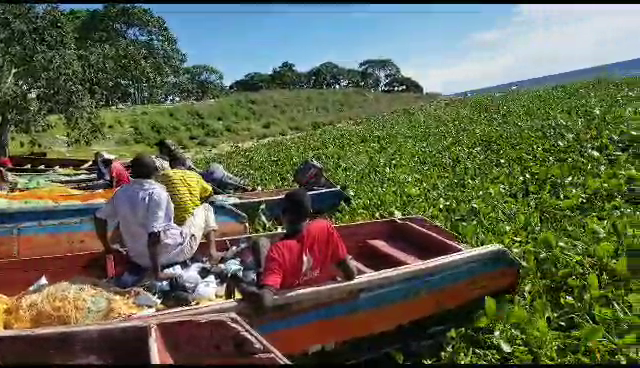By David Sekayinga & Al-Mahdi Ssenkabira
A carpet of heavy water hyacinth has in the past week blocked the shoreline at Kisovve landing site – Lujaabwa Village, Mazinga sub-county in Kalangala District, bringing fishing to halt.
The moving vegetation came with dangerous reptiles including snakes which have since forced residents close to the docking area and abandon their houses.
Currently, the bigger part of the shoreline where boats dock, measuring about 300 meters, is filthy with patches of devastating weed. Kisovve landing site is a key fishing ground for Nile Perch and Tilapia .
“The weed came with snakes and others are still under the water hyacinth. We can’t sleep in houses because we don’t know what could happen to us during the night,” Mr Yasin Kabugo, one of the fishermen at Kisovve landing site said on Tuesday.
Mr Umar Tamale, a youth sub-county representative at the Kalangala District said: “We had hopes of having better catches this month after struggling for some months, but now with this [water hyacinth ] we don’t know when it will go away. We really don’t know where we shall get food because no boat can sail or dock at the landing site.”
The rocky Lujaabwa Village hosts over 2,000 residents.
According to Ms Resty Nakawungu, the District Vice chairperson, the district lacks capacity to uproot the weed, but they are engaging the government to intervene.
“ As a district, we can only afford anti-venom drugs and we have already asked the chief Accounting Officer to provide Shs10 millon so that we can purchase those drugs to help us in snakebite management,” she said.
Kyamuswa County legislator, Mr Moses Kabuusu, said this is the right time for government to use weevils known as Cyrtobagous Salviniae to control the weed.
“Parliament has been giving the government money to use their laboratories to develop that weevil [Cyrtobagous Salviniae ] which can eat the water hyacinth however we see it increasing on the lake,” he said.
Mr Tom Bukenya, the acting commissioner of Fisheries Resources in the Ministry of Agriculture, Animal Industry & Fisheries, said they are already using the weevils to get rid of water hyacinth on water bodies.
“Like at Lambu landing site in Masaka and other landing sites in eastern Uganda, we are using the weevils to control water hyacinth. Due to the decline of water hyacinth, the weevils reduced in number and we are now focusing on increasing their population in the tanks we placed on all those landing sites,3 he said.
“The challenge is that they[weevils ] take time to reduce the water hyacinth, but have a great impact in reducing it’s existence on the water,” he added
The water hyacinth is a highly problematic invasive species and in the past two decades government has tried to combat the weed on different lakes and rivers under the Uganda–Egypt Aquatic Weed Control Project, but the weed has remained resistant and continues to threaten the fishing communities.
According to the Kalangala District Hazard Risk and Vulnerability profile made in 2016 by the disaster management committee from the Office of the Prime Minister Office, the invasion of species including the water hyacinth and green algae are in the fifth position among the disasters being experienced in the district.








